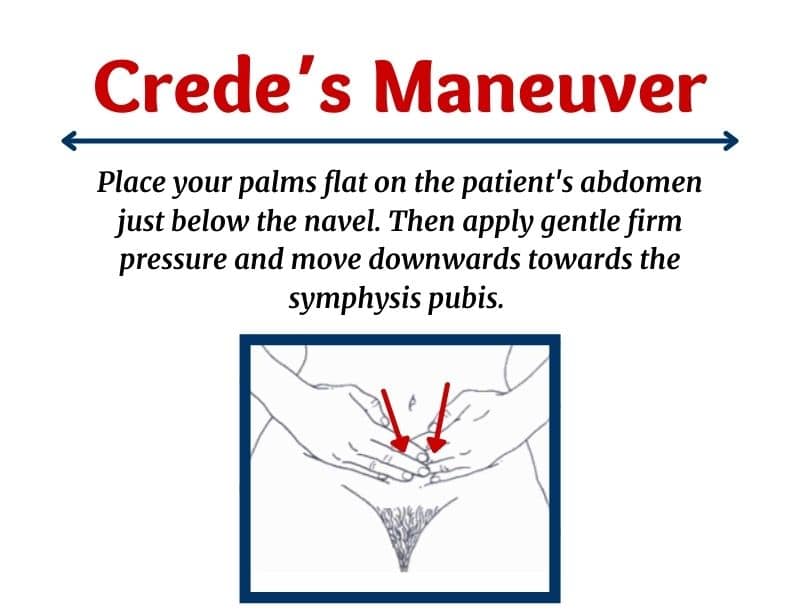Last updated on December 28th, 2023
In this post, you’ll learn about Crede’s Maneuver.
Crede’s Maneuver
The Crede’s maneuver [Credé’s maneuver] refers to the application of manual pressure on the lower abdomen to facilitate complete emptying of the bladder or expulsion of the placenta.
This method is useful to stimulate voiding reflex in patients with flaccid bladder due to spinal cord injury.
History of Crede’s Maneuver
The Crede’s maneuver is named after Carl Siegmund Franz Credé (1819–1892). Crede’s maneuver was first described in 1884 by him as a method to deliver the placenta in case of failed spontaneous placental expulsion after vaginal delivery.
Dr. Credé described the technique as gently massaging over the fundus and the body of the uterus, then gradually increasing the pressure to stimulate strong artificial uterine contraction. At this point then he manually maneuvered the placenta with his hand assisting the expulsion of the placenta.
He reported his technique, now named Crede’s maneuver, was successful in delivering the placenta every single time without fail.
Mechanism of Crede’s Maneuver
Crede’s maneuver helps to relax the external urethral sphincter and increases pressure within the bladder. Thus, promoting the complete evacuation of the bladder.
Sometimes Crede’s maneuver may fail, requiring urinary catheterization to fully empty the bladder.
Indication and Contraindication
Crede’s maneuver may be used in patients with spinal cord injury (SCI), overflow UI (urinary incontinence), inability to empty bladder, and urinary retention.
Crede’s maneuver is contraindicated in conditions such as vesicoureteral reflux (i.e., backflow of urine from the bladder back to ureters), suspected overactive sprinter mechanism, immediately after abdominal surgeries.
How to Perform Crede’s Maneuver
- Verify the advice to perform Crede’s maneuver.
- Gather necessary equipments such as gloves, bedpan/urinal.
- Confirm the patient’s identity as per hospital’s protocol.
- Explain the procedure to the patient to reduce fear and anxiety.
- For bedridden patients – place patient in fowler’s position and correctly position the bedpan or urinal. Make sure the patient is comfortable to promote relaxation.
- Place your palms flat on the patient’s abdomen just below the navel. Then apply gentle firm pressure and move downwards towards the symphysis pubis. Perform this technique several times to stimulate voiding reflex.
- Next, apply final pressure directly over the bladder.
Tips!
- Additionally, if the patient’s condition allows, you can perform Crede’s maneuver at the bathroom or bedside commode.
- Sometimes standing helps for male patients.
- In female patients, ask them to slightly bend forward from the hips after placing hands over the abdomen.
- If the patient is capable, Crede’s maneuver can be performed by himself after teaching the technique.
Crede’s Maneuver – Patient Instructions
- Let the patient place his/her right thumb on the right hip bone and their left thumb on the left hip bone.
- Then ask to stretch the fingers towards their midline, at the level of the navel.
- Gently press on the abdominal wall and slightly lean forward from the hip.
- Next, ask to smoothly move their hands down towards the pubic bone, while pushing in on the abdominal wall.
- Once reached the level of the pubic bone, push deeply inward and downward to help empty the bladder.

Conclusion
Crede’s maneuver is described as the application of firm pressure with hands over the symphysis pubis to help empty the bladder. However, a critical evaluation study of Crede’s maneuver concluded that it is not effective in bladder emptying.
Also, be cautious employing Crede’s maneuver. Since it involves creating forceful manual contraction of the abdominal muscles to increase intra-abdominal pressure which may cause some internal injury.
Reference
Capezuti, E., Zwicker, D., & Mezey, M. (2007). Evidence-Based Geriatric Nursing Protocol for Best Practice (3rd ed.). Springer Pub. Co.
Lippincott Williams & Wilkins. (2002). Illustrated manual of nursing practice (3rd ed.).
Rosdahl, C., & Kowalski, M. (2011). Textbook of Basic Nursing (10th ed.). Wolters Kluwer Health/Lippincott Williams & Wilkins.
Wolters Kluwer/Lippincott Williams & Wilkins Health. (2012). Lippincott’s Nursing Procedures (6th ed.).


